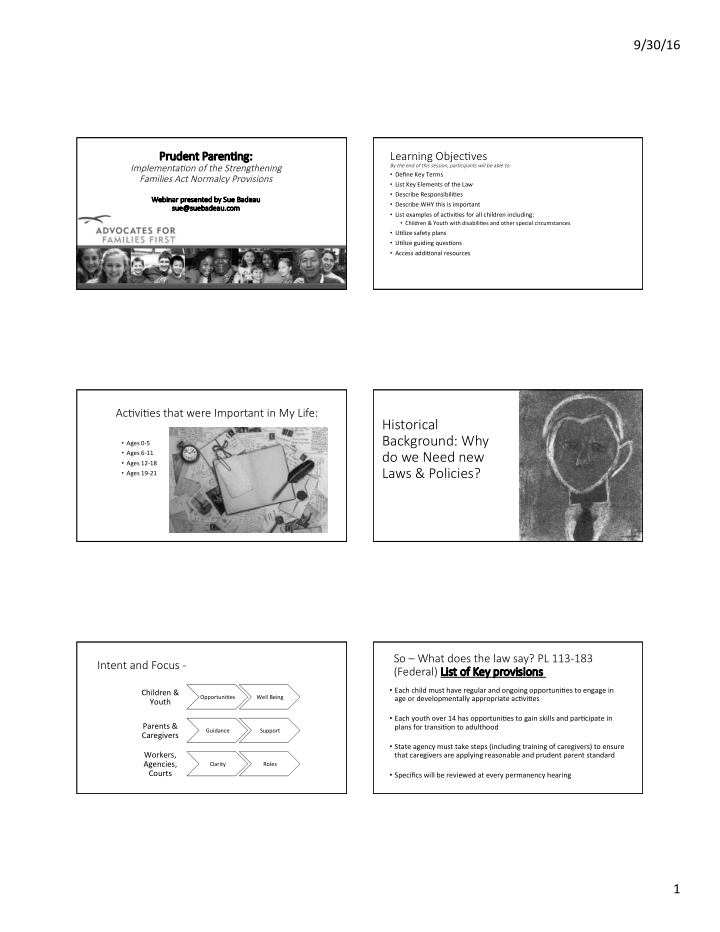



9/30/16 Pruden Prudent P t Par aren*ng: en*ng: Learning Objec*ves By the end of this session, par)cipants will be able to: Implementa)on of the Strengthening • Define Key Terms Families Act Normalcy Provisions • List Key Elements of the Law • Describe ResponsibiliGes Webinar presented by Sue Badeau We • Describe WHY this is important sue@suebadeau.com sue@suebadeau.c • List examples of acGviGes for all children including: • Children & Youth with disabiliGes and other special circumstances • UGlize safety plans • UGlize guiding quesGons • Access addiGonal resources Webinar for Advocates for Families First October 2016 Ac*vi*es that were Important in My Life: Historical Background: Why • Ages 0-5 • Ages 6-11 do we Need new • Ages 12-18 Laws & Policies? • Ages 19-21 So – What does the law say? PL 113-183 Intent and Focus - (Federal) Lis List o t of K f Key pr y provisio visions ns • Each child must have regular and ongoing opportuniGes to engage in Children & OpportuniGes Well Being age or developmentally appropriate acGviGes Youth • Each youth over 14 has opportuniGes to gain skills and parGcipate in Parents & plans for transiGon to adulthood Guidance Support Caregivers • State agency must take steps (including training of caregivers) to ensure Workers, that caregivers are applying reasonable and prudent parent standard Agencies, Clarity Roles Courts • Specifics will be reviewed at every permanency hearing 1
9/30/16 Ke Key Examples of Age or Developmentally Appropriate Ac*vi*es Defini*o Defini*ons ns Reasonable & Normalcy Prudent Parent • Family Life Standard • Peers and Friends • School • Community • Becoming Independent Age or Developmentally A few others . . . Appropriate AcGviGes Who Who do does this la es this law apply t w apply to? “No-No’ “No-No’s” ” What Do I Need to Know? Normalcy for Youth in Special Circumstances ~ Pr Providing Sa viding Safety ty, Inc , Inclusio lusion and O n and Oppo pportunity f rtunity for • Pregnant and ParenGng Teens • Young people who idenGfy as LGBTQ or other non-conforming expressions of gender and sexuality • Youth with history of jusGce-system contact or involvement • Other circumstances? 2
9/30/16 What is Child Trauma? How Does Trauma Affect The Child’s Ability to Safely Engage in Ac*vi*es • Most of the Gme, the child will behave and respond like a typically developing child • A trauma trigger can change that • The child can explode • Or withdraw, shut-down • Or simply take longer to sefle down and be ready to parGcipate • What examples have you seen? Pu`ng the Knowledge All TRAUMA Together: TRIGGERS & Observing and Knowing the SAFETY Child in my Care PLANNING Ethical Decision Making Model Understand The “Ask” Decision Making Model 3
9/30/16 Brainstorm m - Factors to Consider Gather InformaHon • Child's age, maturity and developmental level • Appropriateness of the extracurricular, enrichment, cultural or social acGvity or experience. • Child's wishes. • Encouraging the child's emoGonal and developmental growth. • SupporGng the youth in developing skills to successfully transiGon to adulthood. • Providing the child with the most family-like living experience possible. • Any special needs accommodaGons, or trauma-safety plans that the child may need to safely and fully parGcipate in the acGvity or experience. • PotenGal risk factors to the child or to others • Best interest of the child, based on informaGon known by the caregiver. EVALUATE Decide & Act OPTIONS Does Saying “Yes” Guarantee a Good Outcome ? REFLECT 4
9/30/16 Wrapping Up Avoiding the “L” word (* liability ) • Q & A • EvaluaHons 26 5
Recommend
More recommend